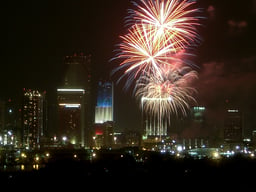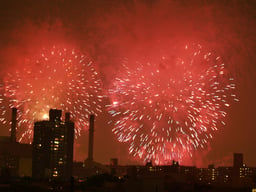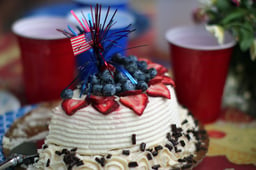Independence Day (United States)
-2nv20kpXt7b6KjUsiClIsVtM0WWrPA)
Independence Day (United States)
-2nv20kpXt7b6KjUsiClIsVtM0WWrPA)
| Independence Day | |
|---|---|
| Also called | The Fourth of July |
| Observed by | United States |
| Type | National |
| Significance | The day in 1776 that the Declaration of Independence was adopted by the Continental Congress |
| Celebrations | Fireworks, family reunions, concerts, barbecues, picnics, parades, baseball games |
| Date | July 4 |
| Next time | July 4, 2020 (2020-07-04) |
| Frequency | annual |
Independence Day (colloquially the Fourth of July or July 4th) is a federal holiday in the United States commemorating the Declaration of Independence of the United States, on July 4, 1776. The Continental Congress declared that the thirteen American colonies were no longer subject (and subordinate) to the monarch of Britain and were now united, free, and independent states.[1] The Congress had voted to declare independence two days earlier, on July 2, but it was not declared until July 4.[1]
Independence Day is commonly associated with fireworks, parades, barbecues, carnivals, fairs, picnics, concerts, baseball games, family reunions, political speeches, and ceremonies, in addition to various other public and private events celebrating the history, government, and traditions of the United States. Independence Day is the national day of the United States.[2][3][4]
| Independence Day | |
|---|---|
| Also called | The Fourth of July |
| Observed by | United States |
| Type | National |
| Significance | The day in 1776 that the Declaration of Independence was adopted by the Continental Congress |
| Celebrations | Fireworks, family reunions, concerts, barbecues, picnics, parades, baseball games |
| Date | July 4 |
| Next time | July 4, 2020 (2020-07-04) |
| Frequency | annual |
Background
During the American Revolution, the legal separation of the thirteen colonies from Great Britain in 1776 actually occurred on July 2, when the Second Continental Congress voted to approve a resolution of independence that had been proposed in June by Richard Henry Lee of Virginia declaring the United States independent from Great Britain's rule.[5][6] After voting for independence, Congress turned its attention to the Declaration of Independence, a statement explaining this decision, which had been prepared by a Committee of Five, with Thomas Jefferson as its principal author. Congress debated and revised the wording of the Declaration, finally approving it two days later on July 4. A day earlier, John Adams had written to his wife Abigail:
The second day of July 1776, will be the most memorable epoch in the history of America. I am apt to believe that it will be celebrated by succeeding generations as the great anniversary festival. It ought to be commemorated as the day of deliverance, by solemn acts of devotion to God Almighty. It ought to be solemnized with pomp and parade, with shows, games, sports, guns, bells, bonfires, and illuminations, from one end of this continent to the other, from this time forward forever more.[7]
Adams's prediction was off by two days. From the outset, Americans celebrated independence on July 4, the date shown on the much-publicized Declaration of Independence, rather than on July 2, the date the resolution of independence was approved in a closed session of Congress.[8]
Historians have long disputed whether members of Congress signed the Declaration of Independence on July 4, even though Thomas Jefferson, John Adams, and Benjamin Franklin all later wrote that they had signed it on that day. Most historians have concluded that the Declaration was signed nearly a month after its adoption, on August 2, 1776, and not on July 4 as is commonly believed.[9][10][11][12][13]
By a remarkable coincidence, Thomas Jefferson and John Adams, the only two signatories of the Declaration of Independence later to serve as presidents of the United States, both died on the same day: July 4, 1826, which was the 50th anniversary of the Declaration, Jefferson even mentioning the fact.[14] (Only one other signatory, Charles Carroll of Carrollton, survived them, dying in 1832[15].) Although not a signatory of the Declaration of Independence, James Monroe, another Founding Father who was elected as president, also died on July 4, 1831. He was the third President who died on the anniversary of independence.[16] Calvin Coolidge, the 30th president, was born on July 4, 1872; so far he is the only U.S. president to have been born on Independence Day.[17]
Observance
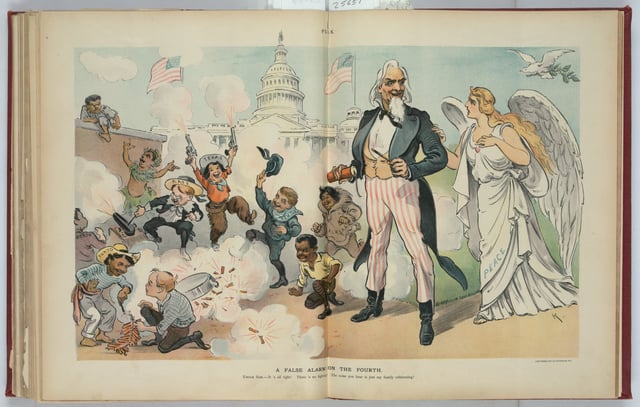
American children of many ethnic backgrounds celebrate noisily in 1902 Puck cartoon
In 1777, thirteen gunshots were fired in salute, once at morning and once again as evening fell, on July 4 in Bristol, Rhode Island. An article in July 18, 1777 issue of The Virginia Gazette noted a celebration in Philadelphia in a manner a modern American would find familiar: an official dinner for the Continental Congress, toasts, 13-gun salutes, speeches, prayers, music, parades, troop reviews, and fireworks. Ships in port were decked with red, white, and blue bunting.[18]
In 1778, from his headquarters at Ross Hall, near New Brunswick, New Jersey, General George Washington marked July 4 with a double ration of rum for his soldiers and an artillery salute (feu de joie). Across the Atlantic Ocean, ambassadors John Adams and Benjamin Franklin held a dinner for their fellow Americans in Paris, France.[19]
In 1779, July 4 fell on a Sunday. The holiday was celebrated on Monday, July 5.[19]
In 1781, the Massachusetts General Court became the first state legislature to recognize July 4 as a state celebration.[19]
In 1783, Salem, North Carolina, held a celebration with a challenging music program assembled by Johann Friedrich Peter entitled The Psalm of Joy. The town claims to be the first public July 4 event, as it was carefully documented by the Moravian Church, and there are no government records of any earlier celebrations.[20]
In 1870, the U.S. Congress made Independence Day an unpaid holiday for federal employees.[21]
In 1938, Congress changed Independence Day to a paid federal holiday.[22]
Customs
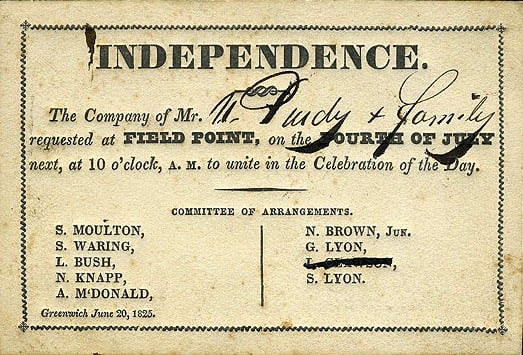
An 1825 invitation to an Independence Day celebration
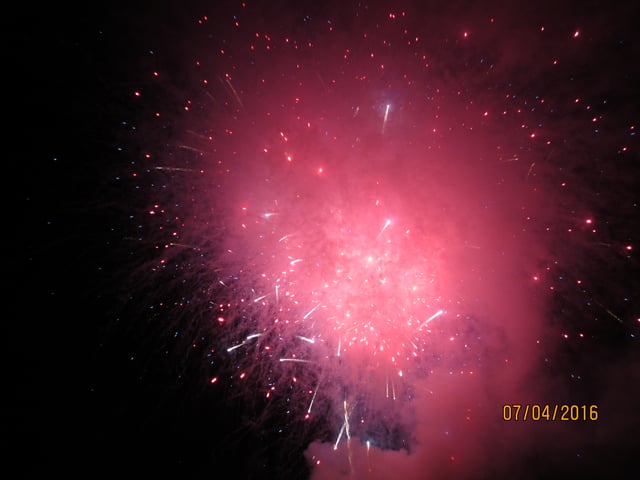
Fireworks on Independence Day in Goleta, California
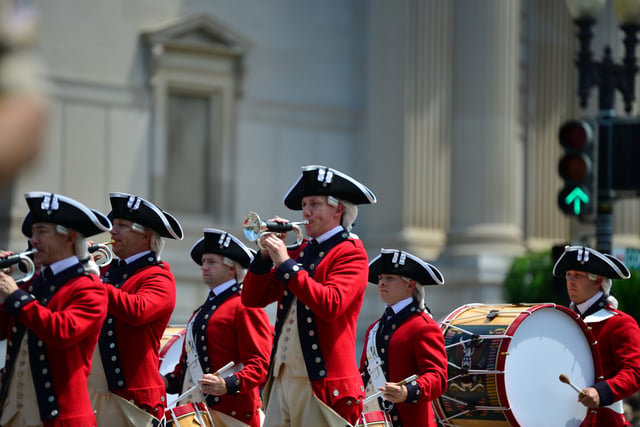
Independence Day Parade in Washington, D.C.
Independence Day is a national holiday marked by patriotic displays. Similar to other summer-themed events, Independence Day celebrations often take place outdoors. According to 5 U.S.C. § 6103 [55] , Independence Day is a federal holiday, so all non-essential federal institutions (such as the postal service and federal courts) are closed on that day. Many politicians make it a point on this day to appear at a public event to praise the nation's heritage, laws, history, society, and people.
Families often celebrate Independence Day by hosting or attending a picnic or barbecue; many take advantage of the day off and, in some years, a long weekend to gather with relatives or friends. Decorations (e.g., streamers, balloons, and clothing) are generally colored red, white, and blue, the colors of the American flag. Parades are often held in the morning, before family get-togethers, while fireworks displays occur in the evening after dark at such places as parks, fairgrounds, or town squares.
The night before the Fourth was once the focal point of celebrations, marked by raucous gatherings often incorporating bonfires as their centerpiece. In New England, towns competed to build towering pyramids, assembled from barrels and casks. They were lit at nightfall to usher in the celebration. The highest were in Salem, Massachusetts, with pyramids composed of as many as forty tiers of barrels. These made the tallest bonfires ever recorded. The custom flourished in the 19th and 20th centuries and is still practiced in some New England towns.[23]
Independence Day fireworks are often accompanied by patriotic songs such as the national anthem, "The Star-Spangled Banner"; "God Bless America"; "America the Beautiful"; "My Country, 'Tis of Thee"; "This Land Is Your Land"; "Stars and Stripes Forever"; and, regionally, "Yankee Doodle" in northeastern states and "Dixie" in southern states. Some of the lyrics recall images of the Revolutionary War or the War of 1812.
Firework shows are held in many states, and many fireworks are sold for personal use or as an alternative to a public show. Safety concerns have led some states to ban fireworks or limit the sizes and types allowed. In addition, local and regional weather conditions may dictate whether the sale or use of fireworks in an area will be allowed. Some local or regional firework sales are limited or prohibited because of dry weather or other specific concerns. On these occasions the public may be prohibited from purchasing or discharging fireworks, but professional displays (such as those at sports events) may still take place, if certain safety precautions have been taken.
A salute of one gun for each state in the United States, called a "salute to the union," is fired on Independence Day at noon by any capable military base.[24]
New York City has the largest fireworks display in the country, with more than 22 tons of pyrotechnics exploded in 2009.[25] It generally holds displays in the East River. Other major displays are in Seattle on Lake Union; in San Diego over Mission Bay; in Boston on the Charles River; in Philadelphia over the Philadelphia Museum of Art; in San Francisco over the San Francisco Bay; and on the National Mall in Washington, D.C.[26]
During the annual Windsor–Detroit International Freedom Festival, Detroit, Michigan hosts one of the largest fireworks displays in North America, over the Detroit River, to celebrate Independence Day in conjunction with Windsor, Ontario's celebration of Canada Day.[27]
The first week of July is typically one of the busiest United States travel periods of the year, as many people use what is often a three-day holiday weekend for extended vacation trips.[28]
Celebration gallery
Play media
Patriotic trailer shown in theaters celebrating July 4, 1940
[[INLINE_IMAGE|//upload.wikimedia.org/wikipedia/commons/thumb/e/ef/Miamifireworks.jpg/267px-Miamifireworks.jpg|//upload.wikimedia.org/wikipedia/commons/thumb/e/ef/Miamifireworks.jpg/400px-Miamifireworks.jpg 1.5x, //upload.wikimedia.org/wikipedia/commons/thumb/e/ef/Miamifireworks.jpg/533px-Miamifireworks.jpg 2x||h200|w267]]
In addition to a fireworks show, Miami, Florida, lights one of its tallest buildings with the patriotic red, white and blue color scheme on Independence Day.
[[INLINE_IMAGE|//upload.wikimedia.org/wikipedia/commons/thumb/f/f9/Fireworks_over_the_East_Village_of_New_York_City.JPG/267px-Fireworks_over_the_East_Village_of_New_York_City.JPG|//upload.wikimedia.org/wikipedia/commons/thumb/f/f9/Fireworks_over_the_East_Village_of_New_York_City.JPG/400px-Fireworks_over_the_East_Village_of_New_York_City.JPG 1.5x, //upload.wikimedia.org/wikipedia/commons/thumb/f/f9/Fireworks_over_the_East_Village_of_New_York_City.JPG/533px-Fireworks_over_the_East_Village_of_New_York_City.JPG 2x||h200|w267]]
New York City's fireworks display, shown above over the East Village, is sponsored by Macy's and is the largest[25] in the country.
[[INLINE_IMAGE|//upload.wikimedia.org/wikipedia/commons/thumb/c/c3/Fourth_of_July_Cake.jpg/270px-Fourth_of_July_Cake.jpg|//upload.wikimedia.org/wikipedia/commons/thumb/c/c3/Fourth_of_July_Cake.jpg/405px-Fourth_of_July_Cake.jpg 1.5x, //upload.wikimedia.org/wikipedia/commons/thumb/c/c3/Fourth_of_July_Cake.jpg/540px-Fourth_of_July_Cake.jpg 2x||h180|w270]]
A festively decorated Independence Day cake
Notable celebrations
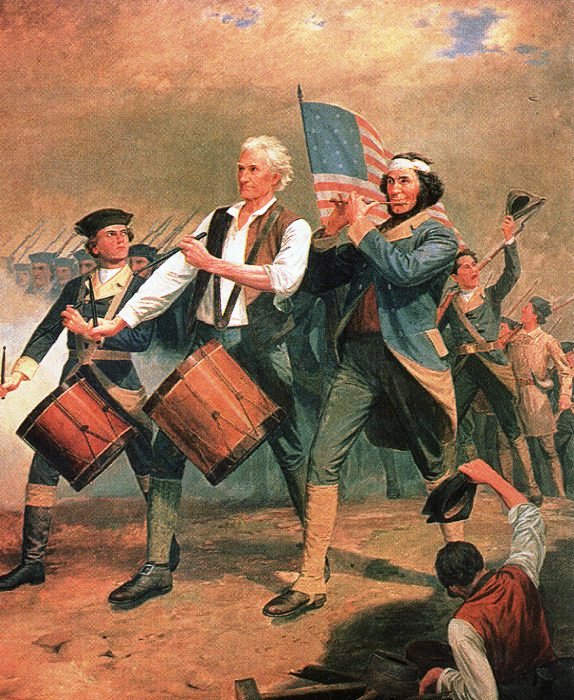
Originally entitled Yankee Doodle, this is one of several versions of a scene painted by A. M. Willard that came to be known as The Spirit of '76. Often imitated or parodied, it is a familiar symbol of American patriotism

The 2019 Independence Day parade in Washington, D.C.
Held since 1785, the Bristol Fourth of July Parade in Bristol, Rhode Island, is the oldest continuous Independence Day celebration in the United States.[29]
Since 1868, Seward, Nebraska, has held a celebration on the same town square. In 1979 Seward was designated "America's Official Fourth of July City-Small Town USA" by resolution of Congress. Seward has also been proclaimed "Nebraska's Official Fourth of July City" by Governor James Exon in proclamation. Seward is a town of 6,000 but swells to 40,000+ during the July 4 celebrations.[30]
Since 1912, the Rebild Society, a Danish-American friendship organization, has held a July 4 weekend festival that serves as a homecoming for Danish-Americans in the Rebild Hills of Denmark.[31]
Since 1959, the International Freedom Festival is jointly held in Detroit, Michigan, and Windsor, Ontario, during the last week of June each year as a mutual celebration of Independence Day and Canada Day (July 1). It culminates in a large fireworks display over the Detroit River.
The famous Macy's fireworks display usually held over the East River in New York City has been televised nationwide on NBC since 1976. In 2009, the fireworks display was returned to the Hudson River for the first time since 2000 to commemorate the 400th anniversary of Henry Hudson's exploration of that river.[32]
The Boston Pops Orchestra has hosted a music and fireworks show over the Charles River Esplanade called the "Boston Pops Fireworks Spectacular" annually since 1973.[33] The event was broadcast nationally from 1991 until 2002 on A&E, and since 2002 by CBS and its Boston station WBZ-TV. WBZ/1030 and WBZ-TV broadcast the entire event locally, and from 2002 through 2012, CBS broadcast the final hour of the concert nationally in primetime. The national broadcast was put on hiatus beginning in 2013, which Pops executive producer David G. Mugar believed was the result of decreasing viewership caused by NBC's encore presentation of the Macy's fireworks.[34][35] The national broadcast was revived for 2016, and expanded to two hours.[36] In 2017, Bloomberg Television took over coverage duty, with WHDH carrying local coverage beginning in 2018.[37]
On the Capitol lawn in Washington, D.C., A Capitol Fourth, a free concert broadcast live by PBS, NPR and the American Forces Network, precedes the fireworks and attracts over half a million people annually.[38]
In 2019, President Donald Trump announced plans for a Salute to America celebration in the Capitol, including displays of military vehicles at the National Mall, a presidential address from the steps of the Lincoln Memorial, flyovers by the Blue Angels and the presidential aircraft, and a fireworks display. Trump had attended the Bastille Day military parade with French president Emmanuel Macron in 2017, and had expressed a desire for the U.S. to "top it" — including a proposed military parade on Veterans Day in 2018, which was cancelled due to cost concerns.[39][40][41] Trump's plans faced criticism at the time for being an attempt to politicize the holiday and use it as a political event due to presidents historically not involving themselves directly in Independence Day festivities; comparisons were also drawn to the similarly controversial "Honor America Day" held on Independence Day in 1970 by supporters of President Richard Nixon.[42][40][41] According to a July 4 The Times article, the Pentagon said that the commanders of the Joint Chiefs of Staff of the United States Navy, United States Army, United States Air Force, and United States Marine Corps would "not attend President Trump's Salute to America speech because of "schedule conflict," although the chairman of the Joint Chiefs did attend.[43]
Other countries
The Philippines celebrates July 4 as its Republic Day to commemorate that day in 1946 when it ceased to be a U.S. territory and the United States officially recognized Philippine Independence.[44] July 4 was intentionally chosen by the United States because it corresponds to its Independence Day, and this day was observed in the Philippines as Independence Day until 1962. In 1964, the name of the July 4 holiday was changed to Republic Day. Rebild National Park in Denmark is said to hold the largest July 4 celebrations outside of the United States.[45]

